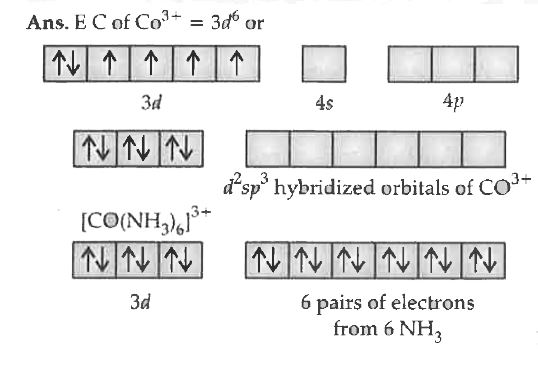With the help of valence bond theory account for the geometry and magnetic property of (Co(NH3)6)3+.Solution in Kannada

Geometry : Octahedral
Magnetic property : Diamagnetic
Topper's Solved these Questions
- BOOK - OSWAAL PUBLICATIONCHAPTER - CO-ORDINATION COMPOUNDSEXERCISE - TOPIC-2 (WERNER.S THEORY BONDING IN CO-ORDINATION COMPOUND , VBT, CFT AND IMPORTANCE OF CO-ORDINATION COMPOUNDS) (Short Answer Type Questions)9videos
CO-ORDINATION COMPOUNDS
- BOOK - OSWAAL PUBLICATIONCHAPTER - CHEMISTY IN EVERYDAY LIFEEXERCISE - LONG ANSWER TYPE QUESTIONS-I1videos
CHEMISTY IN EVERYDAY LIFE
- BOOK - OSWAAL PUBLICATIONCHAPTER - D - BLOCK ELEMENTS F - BLOCK ELEMENTS EXERCISE - TOPIC - 2 (F - BLOCK ELEMENT , LANTHANOIDS AND ACTINOIDS)(LONG ANSWER TYPES QUESTIONS)6videos
D - BLOCK ELEMENTS F - BLOCK ELEMENTS
Similar Questions
Mention any two characteristics of bonding molecular orbitals.
02:41View Solution(a) Why are detergents called soapless soap ?
(b) Why do soaps not work in hard water ?02:05View SolutionCompare the chemistry with that of the lanthanoids with special reference to (i) electronic configuration (ii) atomic and ionic sizes (iii) oxidation state (iv) chemical reactivity .
04:40View SolutionExplain with the help of valence bond theory, the geometry and magnetic nature of [MnCl6]4−
05:29View SolutionGive an account of the valence bond theory . Explain the geometry and magnetic behaviour of the complex ion [Fe(CN)6]4− on the basis of the theory .
05:18View SolutionDiscuss the bonding in the coordination entity [CO(NH3)6]3+ on the basis of valence bond theory. Also, comment on the geometry and SQPin of the given entity. (Atomic no. of Co= 27)
05:29View Solutionसंयोजकता बंध सिद्धांत के आधार पर संकुलन [CoF6]3− की ऑक्सीजन अवस्था, संकरण, ज्यामिति एवं चुम्बकीय प्रकृति को समझाइए।
View SolutionOn the basis of valence bond theory, explain geometry, nature of hybridisation, magnetic property and optical isomerism of [Co(ox)3]3−and[CoF6]3−.
05:54View Solutionसंयोजकता बंध सिद्धांत के आधार पर संकुल [CoF6]3− कि ऑक्सीकरण अवस्था, संकरण, ज्यामिति एवं चुंबकीय प्रकृति को समझाइये।
03:05View SolutionWith the help of Valence Bond Theory (VBT) explain hybridisation, geometry and magnetic property of [CoF_6]^2 heat fluoridocobaltate (III) ion.
02:38View SolutionWith the help of Valence Bond theory account for hybridisation, geometry and magnetic property of [Ni(CN)4]2− complex ion [Z for Ni=28]
02:15View SolutionUsing valence bond theory (VBT), account for the geometry, type of hybridization and magnetic property of [NiCl4]2−.
View SolutionWith the help of valence bond theory account for the geometry and magnetic property of (Co(NH3)6)3+.
02:15View SolutionUsing valence bond theory explain geometry, hybridisation and magnetic property of [CoF_6]_3^- (Atomic number of Co = 27).
03:19View SolutionUsing the valence bond theory predict the geometry and magnetic behaviour of [CoF6]3−.
[At. no. of Co = 27]03:39View SolutionUsing valence bond theory explain geometry, hybridisation and magnetic property of [CoF6]−3 (Atomic number of Co = 27).
02:15View Solution

